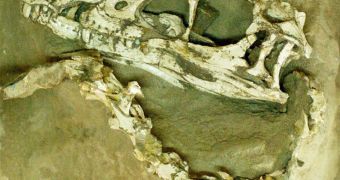Researchers have recently determined that an ancient, crocodile-like reptile had an appetite for eating sea turtles, as well as dinosaurs. According to evidence found on bones and shells, it would seem that the predator, which was about the length of two modern cars, did not resent eating most things it could find, even if they were all bony. The giant reptile is believed to have been as common at its location – river banks in what is known the state of Georgia – as the modern-day crocodile is on the banks of the West Nile river, LiveScience reports.
The creature is known as Deinosuchus. Technically speaking, it is a lot closely related to alligators than crocodiles, though the two species are very similar. The fossil record shows that the creature could grow to reach a length of no less than 29 feet, or about 9 meters, and that it had a large number of very powerful teeth. Investigators propose that its main source of food were sea turtles, but add that the reptile had no issue with taking down dinosaurs its own size. Several fossilized bones look as if they were a dog's bone toy, being incredibly deformed from the large number of teeth marks on them.
“We're sure (Deinosuchus) ate a lot of sea turtles, but it's evident it liked to prey on dinosaurs too,” explains the leader of the new investigation, Columbus State paleontologist David Schwimmer. He is also the author of two new studies on the issue, which he conducted together with student Samantha Harrell, also at the university. The beast apparently lived some 79 million years ago, the team adds. They say that the reason why they believe the animal was feeding on larger prey is the level of tooth decay fossils exhibit. The loss of tooth tips is equivalent to chewing on tough materials such as bones.
“These things had very thick blunt teeth, built like little hub caps, especially the back teeth,” says Schwimmer. Fossils of duck-billed dinosaurs living in what is now the western United States were found to have tailbones covered in the distinctive markings left behind by Deinosuchus. The leg of another predator dinosaur, which was found in a New Jersey museum, also showed the same signs. “The [leg] bone was so chewed that it was distorted, and it looked like a chew toy, like a dog had been working on it. It was covered with crocodilian bites,” the group leader concludes.

 14 DAY TRIAL //
14 DAY TRIAL //